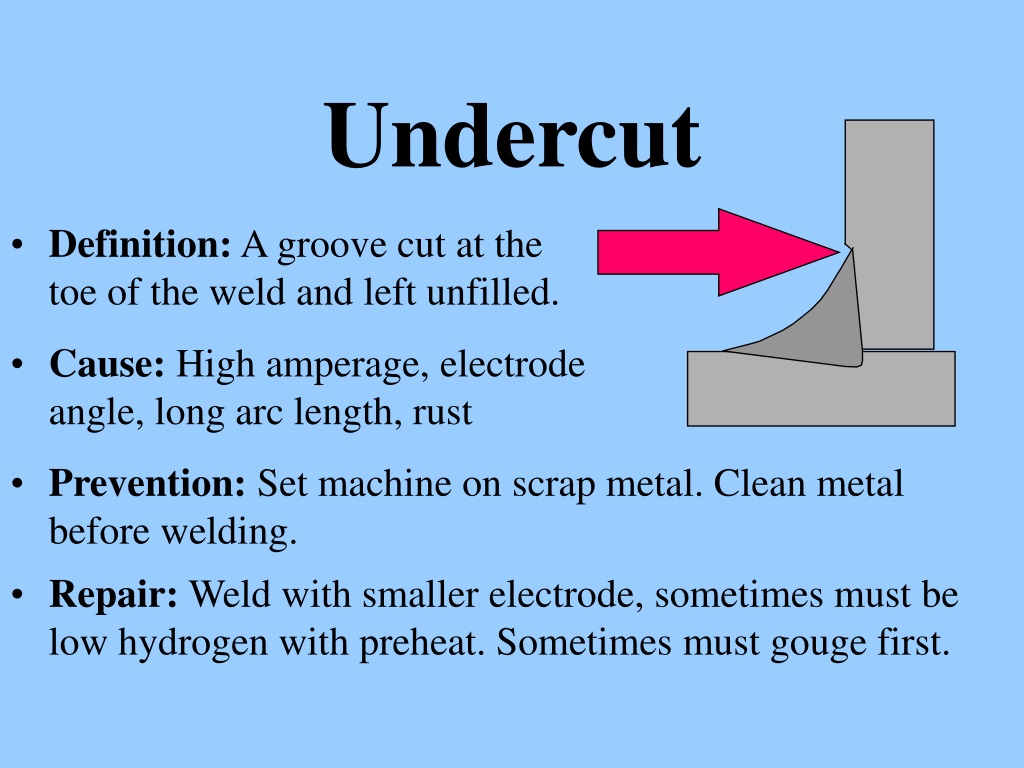Preventing Weld Undercut Demystified: Methods for Success
Preventing Weld Undercut Demystified: Methods for Success
Blog Article
Mastering the Art of Welding: How to Stay Clear Of Undercut Welding Issues for Flawless Construction Outcomes
Effectiveness and precision are vital on the planet of welding, where even the slightest flaw can jeopardize the structural integrity of a produced item. One usual difficulty that welders face is undercutting, a problem that can weaken a weld joint and lead to pricey rework. By recognizing the root causes of undercut welding and executing reliable techniques to avoid it, welders can boost their craft to brand-new levels of excellence (Preventing weld undercut). In the pursuit of flawless manufacture results, mastering the art of welding to stay clear of undercut issues is not simply an ability yet a necessity for those pursuing excellence in their job.
Recognizing Undercut Welding

To prevent undercut welding, welders must ensure correct welding specifications, such as readjusting the present, voltage, traveling speed, and maintaining the proper electrode angle. By understanding the reasons of undercut welding and executing preventive actions, welders can achieve high-grade, structurally audio welds.
Root Causes Of Undercut in Welding
Understanding the elements that add to undercut in welding is necessary for welders to generate top quality, structurally audio welds. Damaging occurs when the weld steel does not properly load the groove created in between the base steel and the previously deposited weld metal. Numerous elements can lead to damage in welding. One usual reason is too much warm input. Welding at heats for prolonged durations can lead to the base steel thawing more than desired, causing undercut. Inadequate welding wrong or present welding rate can also contribute to undercut. Not enough current may not supply adequate heat to thaw the base and filler steels properly, while too much speed can protect against proper combination, causing undercut. Additionally, incorrect electrode angles or inaccurate torch control strategies can create locations of reduced weld steel deposition, promoting undercut. Understanding these causes and implementing correct welding techniques can aid avoid undercutting issues, making sure durable and solid welds.
Methods to Stop Undercutting

To minimize the danger of undercutting in welding, welders can utilize strategic welding strategies aimed at enhancing the top quality and honesty of the weld joints. One effective method is to change the welding criteria, such as voltage, existing, and take a trip rate, to ensure correct heat input and deposition. Preserving a suitable electrode angle and guaranteeing consistent traveling rate can look here likewise assist stop undercut. In addition, making use of the proper welding method for the particular joint configuration, such as weave or stringer beads, can add to minimizing undercutting. Preventing weld undercut.
Using back-step welding strategies and controlling the weld grain account can additionally help disperse warmth evenly and reduce the danger of undercut. Regular evaluation of the weld joint during and after welding, as well as executing quality assurance steps, can assist in spotting and dealing with damaging problems quickly.
Importance of Proper Welding Specifications
Selecting and preserving suitable welding specifications is necessary for attaining effective welds with marginal issues. Welding parameters refer to variables such as voltage, existing, travel rate, electrode angle, and securing gas flow rate that straight affect the welding process. These criteria must be carefully changed based on the kind of product being bonded, its density, and the welding method utilized.
Correct welding criteria make certain the correct amount of heat is applied to thaw the base metals and filler material consistently. If the specifications are established too high, it can lead to extreme heat input, creating distortion, spatter, or burn-through. On the other hand, if the specifications are as well low, insufficient blend, absence of penetration, or undercutting may happen.
Quality Control in Welding Workflow

Verdict
To conclude, understanding the art of welding calls for a thorough understanding of undercut welding, its causes, and techniques to avoid it. By guaranteeing proper welding criteria and applying quality control methods, flawless fabrication results can be attained. It is essential for welders to continually pursue quality in their welding operations to avoid undercut issues and generate high-grade welds.
Undercut welding, a common defect in welding processes, takes place when the weld metal doesn't appropriately fill up the groove investigate this site and leaves a groove or anxiety along the welded joint.To stop undercut welding, welders should make sure proper welding parameters, such as changing the current, voltage, traveling speed, and keeping the appropriate electrode angle. Insufficient welding wrong or existing welding speed can additionally add to damage.To mitigate the danger of damaging in welding, welders can use critical welding methods intended at enhancing the quality and honesty of the weld joints.In final thought, mastering the art of welding needs a comprehensive understanding of undercut welding, its causes, and techniques to avoid it.
Report this page